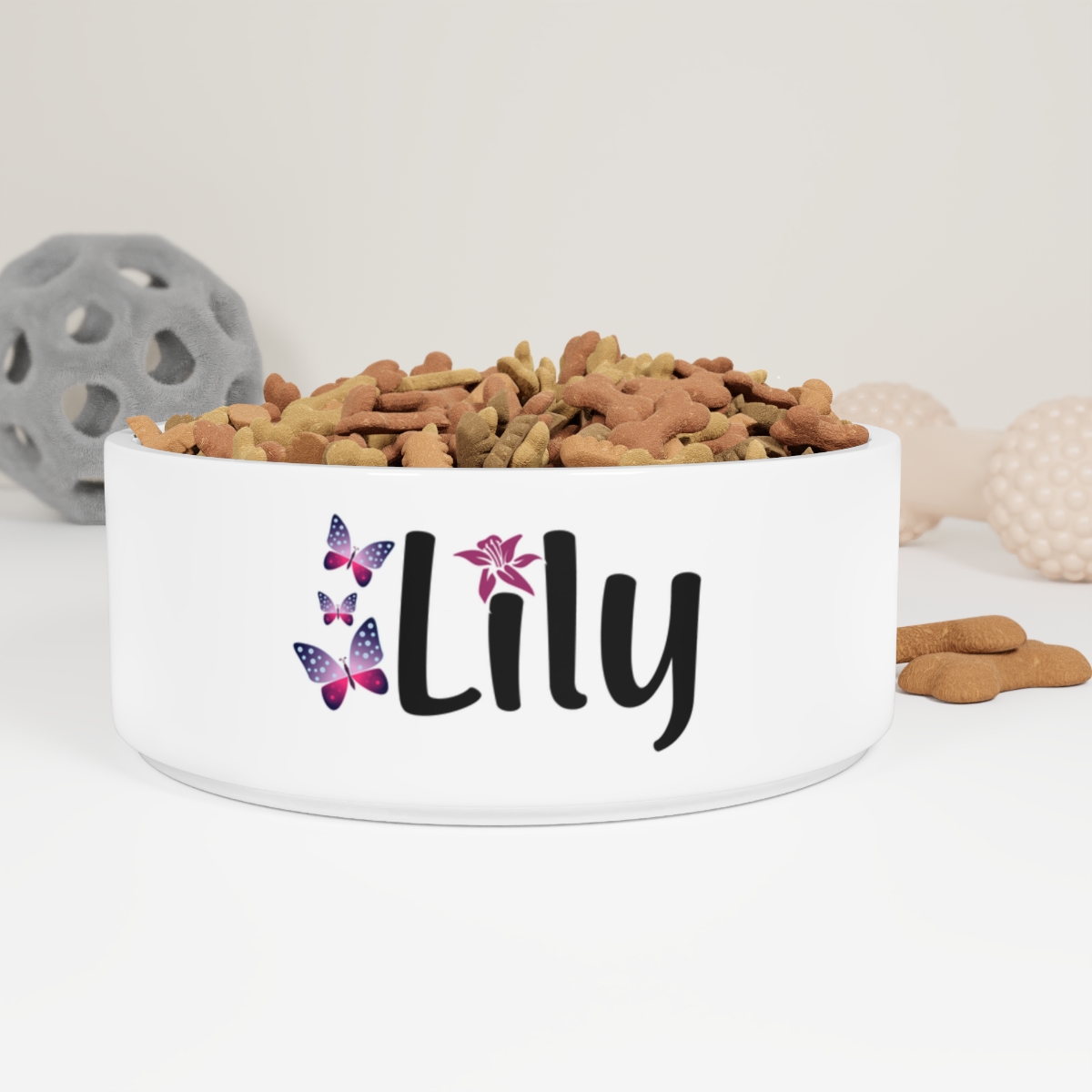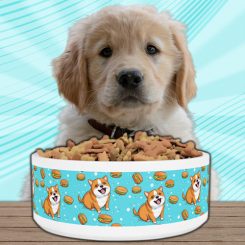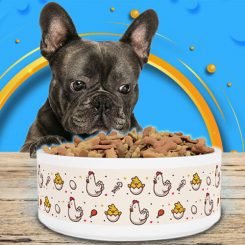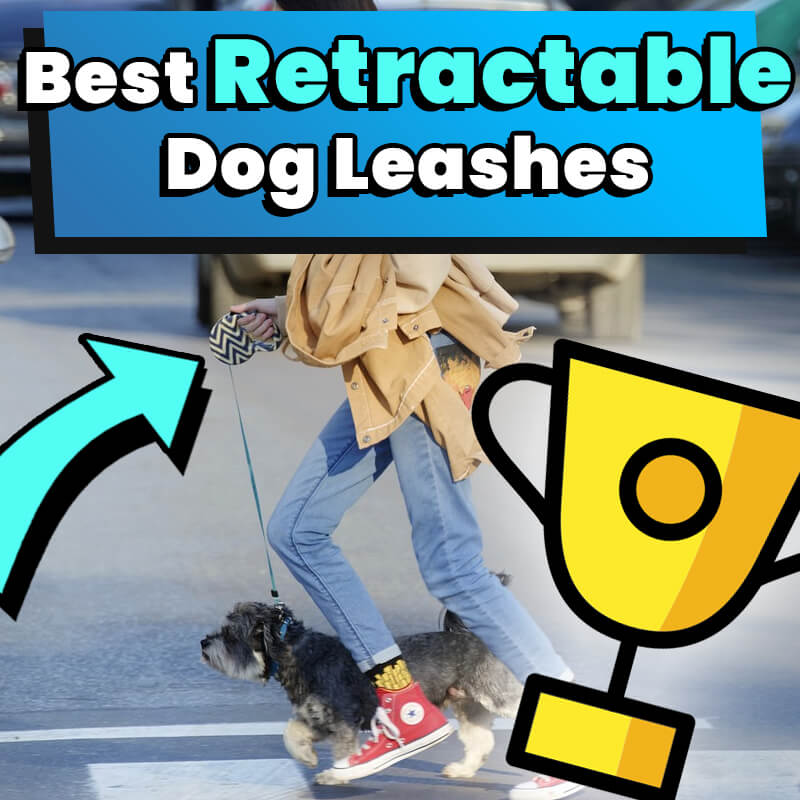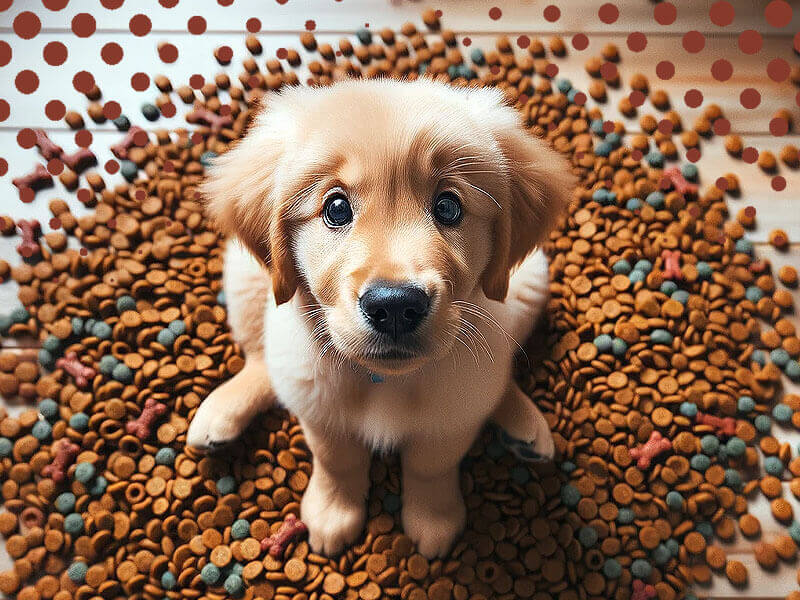
Why do dogs play with their food? Dogs play with their food due to instinct, curiosity, or for mental stimulation. In the wild, dogs had to hunt and interact with their food, which could explain this playful behavior. Additionally, some dogs play with their food when they are not hungry or if they find their food less palatable. Providing interactive toys or changing their diet can help mitigate this behavior.
RECOMMENDED: Are Ceramic Bowls Safe For Dogs?
Table of Contents
What does it mean if your dog plays with their food?
When a dog plays with his food, he could be expressing his playful and exploratory nature.
Dogs are known to use play as a way to learn about their environment and to engage with their owners.
Playing with food can also be a sign that the dog is not hungry or is not interested in the food provided.
It’s important to observe your K9 friend’s behavior and consult with a veterinarian if you have concerns about your dog’s eating habits or health.
Why Does My Dog Play With His Food?
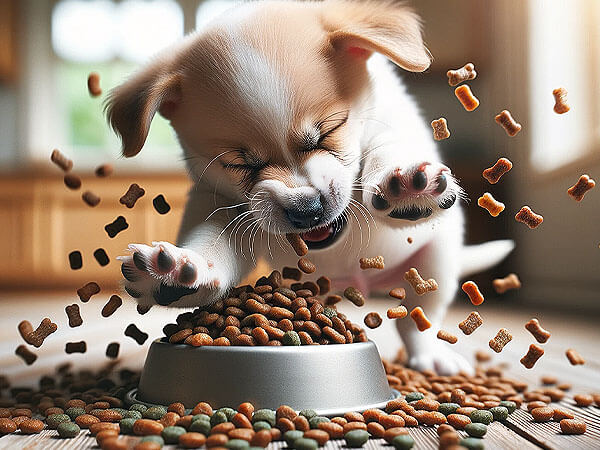
Since puppyhood, I noticed my dog plays with her food during every mealtime. Is this normal behavior?
From the playful nudges to outright food guarding, dogs have myriad ways to interact with their food beyond the simple act of consumption. Based on my research and experiences, here are the top fifteen (15) reasons behind these quirky habits.
Why Do Dogs Play With Food? 15 Reasons Why Dogs Play With Their Food!
1. Instinctual Behavior
One of the primary reasons why dogs play with their food is rooted in their ancestral instincts.
Are you wondering, “Why does my dog play with her food before eating?” It could be because before domestication, wild canines would catch their prey and often play with it before finally consuming it.
This behavior can be observed in modern-day dogs when they mimic the act of catching their food, even if it’s kibble!
2. Taste and Texture Exploration
Dogs, especially puppies, explore the world with their mouths. Playing with their food allows them to familiarize themselves with the texture, smell, and taste. They’re simply curious creatures, always eager to engage with their environment.
READ ALSO: Can Dogs Eat Spoiled Meat? The Dangerous Truth!
3. Not the best pet bowl
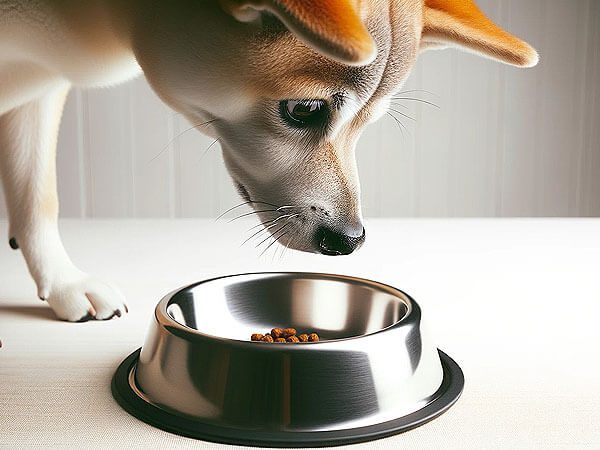
If your dog plays with the food bowl, especially an empty food bowl, it might indicate that they find the bowl uncomfortable or intimidating. The pet bowl might be too deep, too shallow, or they might not like the noise it makes.
As mentioned by Shannon Nowak, BS, LVT, RVT in Today’s Veterinary Nurse, “Dogs and cats have a more developed sense of hearing than humans, so the noise from a…metal bowl can be much louder for them. This noise can be especially startling or even painful if the bowl is placed directly on a tile or hardwood floor. Furthermore, the feel of a bowl against a pet’s whiskers can also be unpleasant.”
This could lead to behaviors like your dog acting weird around the food bowl or your dog playing with the food bowl.
Trying a different food bowl or feeding mat can often resolve this.
4. Entertainment
Sometimes, it’s just fun! Dogs play with food as a way to entertain themselves, especially if they’re left alone during meal times.
That’s why there are brands like Beneful Playful Life dog food or pet play dog food. They have textures or shapes our canine friends find intriguing and this encourages them to play.
5. Dental Benefits
Gnawing and playing can help in cleaning their teeth and gums.
6. Dental Issues
A dog nosing food but not eating, or picking up food and dropping it, might indicate dental problems. Pain or discomfort can deter them from eating directly from the bowl.
According to All Pets Veterinary Hospital, “Some of the most common symptoms of dental disease in dogs can include: Bad breath (halitosis), Visible tartar, Difficulty with or slow eating, Pawing at their teeth or mouth, Missing or loose teeth, Excessive drooling, Bleeding, swollen or noticeably red gums, Weight loss.”
Regular vet check-ups can address and prevent such issues.
RELATED: How Long Can A Dog Go Without Eating?
7. Dog Guarding Food But Not Eating
Some pet owners may find their dog guarding food but not eating. This behavior is quite noticeable.
Some dogs play with their food as a way of guarding it from others. They want to make sure their food is protected and safe from theft.
Also, dogs might display this when they want to establish dominance or when they feel threatened. It’s crucial to recognize and address this behavior appropriately to prevent aggression.
RECOMMENDED: Why Are Chihuahuas So Aggressive? 7 Shocking Reasons
8. Taste Disapproval
If you find your dog playing with food not eating, they might not like the flavor of the new dog food. If your dog plays with one specific food type (like my dog plays with his food that has carrots), trying a different flavor or brand like the Ollie Fresh Dog Food might be the solution.
Why does my dog play with his food and not eat it?
If your dog plays with his food but doesn’t eat it, it could be due to a variety of reasons.
For instance, your pooch might be experiencing stress or anxiety, which can affect his appetite.
Changes in the household, such as a new pet or family member, can cause stress for some dogs.
Additionally, if your pup is not feeling well or is experiencing pain, they might play with their food as a way to distract themselves.
It’s important to observe your dog’s behavior and consult with a veterinarian if you have concerns about their health or eating habits.
9. Digestive Reasons
Your dogs may be playing with their food because doing so might stimulate their digestive system, which in return prepares them to eat.
READ NEXT: How to Get Your Dog to Eat When Sick
10. Distraction
External factors, such as a noisy environment, might distract them, leading your K9 friends to play with their food instead of eating their food.
11. Hunting Simulation
Dogs have an inherent need to hunt. So, when a dog takes food out of the bowl to eat or moves it around (which may look like they’re playing with their food), they could be mimicking hunting behavior.
As we can see, playing simulates the hunt-kill-eat sequence, satisfying their predatory instincts.
12. Seeking Attention
Sometimes, dogs indulge in activities like taking food out of the bowl or carrying it away to grab your attention. Dogs often realize that such behavior gets them attention, especially if they’ve seen your reactions.
It’s their unique way of interacting with you or asking you to participate in their ‘play’.
13. Comfort and Safe Spaces
Have you ever noticed that your dog takes food out of bowl to eat? Some dogs prefer eating in a more secluded, safe, or comfortable spot. It may be a cozy corner or next to their favorite human.
This is why a dog carries food away from the bowl or takes food to another location.
DON’T MISS: How Long Can A Dog Go Without Water?
So, Why do some dogs take their food to the carpet?
Some dogs might take their food to the carpet as a way to create a more comfortable or secure eating environment.
This behavior could be a result of the dog’s natural instincts to find a safe and cozy spot for consumption, away from potential threats or disturbances.
Additionally, your dog might prefer the texture or temperature of the carpet compared to other surfaces.
It’s important to observe your dog’s behavior and consider any changes in their environment or routine that might be influencing this behavior.
If the behavior persists or if you have concerns about your dog’s health or eating habits, consult with a veterinarian.
14. Social Influence
If you have multiple pets in your home, one of your pup’s behavior can influence others. If one starts playing with their food, others might follow suit thinking it’s a new game.
15. Boredom
Sometimes, boredom can be a simple reason. Dogs might turn anything, even their food, into a toy.
Therefore, don’t be surprised when your bored dog starts playing with his food and finding it amusing.
Ensuring they have enough toys such as dog bones, exercise, and stimulation can divert this energy elsewhere.
For more information on recognizing and addressing dog boredom, check out this expert advice from American Kennel Club (AKC).
Why Is My Dog Taking Food Out Of The Bowl?
Why does my dog pick up food and drop it? This behavior can be attributed to:
- Comfort: Dogs might find it more comfortable to eat on a flat surface or a favorite spot.
- Privacy: Some dogs prefer to eat away from the hustle and bustle of household activity.
- Guarding Instincts: Moving and dog guarding food can be a way to ensure it’s safe from other pets or perceived threats.
- Uncomfortable bowl experience: If a dog is acting weird around the food bowl, the bowl itself might be the issue. Metallic bowls might make noises, or deep bowls could irritate their whiskers.
This is why it’s crucial to choose the right dog bowl to ensure your pup has a comfortable and stress-free mealtime, as the wrong bowl can lead to odd behaviors or irritation, such as whisker fatigue from deep bowls or anxiety from the noise of metallic bowls.
A ceramic dog bowl is an excellent choice as it is typically quieter and can be more comfortable for your dog, preventing any adverse reactions during feeding.
Why do dogs move their food around in the bowl?
Dogs may move their food around in the bowl for several reasons.
One possibility is that your furry friend is searching for a specific piece of food that he prefer, especially if his meal consists of a mix of different food types.
Another reason could be that your dog is trying to create a more comfortable eating position. Some dogs may move their food around to prevent discomfort from the bowl pressing against their whiskers or face.
Additionally, by moving the food around, your pup may be enhancing his sense of smell, which is a significant part of his eating experience.
Lastly, your K9 friends may be exhibiting playful behavior or trying to engage with their owner by moving the food around in the bowl.
Moving Food & Taking It to Another Room
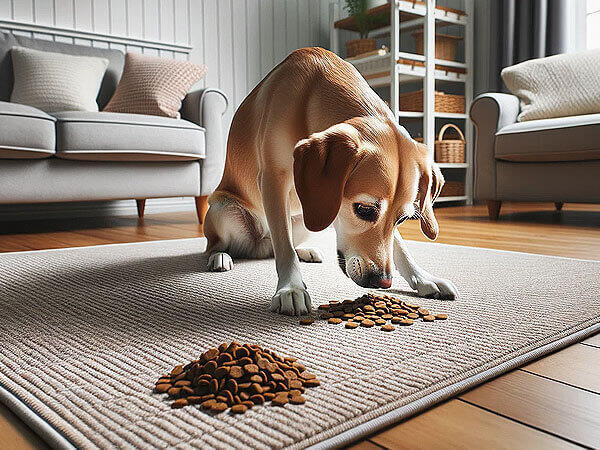
When your canine friends are moving their food from their bowl, you may think that they are playing with their food.
However, the act of a dog taking food away from the bowl or carrying it to another room can be due to the following:
- Safety: In multi-pet households, a dog might carry food away from the bowl to avoid competition.
- Environment: The ambiance of another room might be quieter or more comfortable.
- Nostalgia: Strangely enough, this can be an inherited behavior from a time when they needed to hide excess food from predators.
Other Noteworthy Observations
- Dog Nosing Food But Not Eating: This could indicate a lack of hunger, dental issues, or disinterest in the food.
- Pet Play Dog Food & Pretend Play: Some brands like Beneful Playful Life dog food incorporate playful elements and are nutritionally balanced.
- Bowl Play: If your dog plays with his empty food bowl, they might be signaling they’re still hungry or just find it fun!
CHECK OUT: How Long Can A Puppy Go Without Eating or Drinking?
Final Thoughts
In conclusion, our furry friends have a multitude of reasons behind their behaviors. As responsible dog owners, it’s vital to observe, understand, and adapt to make mealtimes a pleasant experience.
Remember, every dog is unique. While one might indulge in pretend play dog food scenarios, another might just want a quiet corner to munch away. Know your pet, and you’ll decode their actions effortlessly.
Be sure to always monitor your pup for any sudden changes in behavior. Consult your vet if you’re concerned about your dog’s eating habits or health. Your furry friend’s playful interaction with their food is just one of the many quirks that make them so endearing. Enjoy every moment!
DISCLAIMER: THIS WEBSITE DOES NOT PROVIDE MEDICAL ADVICE
The information, including but not limited to, text, graphics, images and other material contained on this website are for informational purposes only. No material on this site is intended to be a substitute for professional veterinary advice, diagnosis, or treatment. Always seek the advice of your veterinarian or other qualified health care provider with any questions you may have regarding a medical condition.
Resources:
AKC: https://www.akc.org/expert-advice/health/treating-dog-anxiety/
Reader’s Digest: https://www.rd.com/article/why-dogs-bring-their-food-somewhere-else-to-eat-it/

With over five years of specialized experience as an animal writer, my expertise lies in dog nutrition, health, behavior, grooming, and training. I am dedicated to delivering helpful and informative content that caters to the well-being of our furry friends. My primary goal is to empower pet owners with knowledge and ensure our canine companions thrive in health and happiness. In my free time, I love volunteering at local dog rescue centers.








